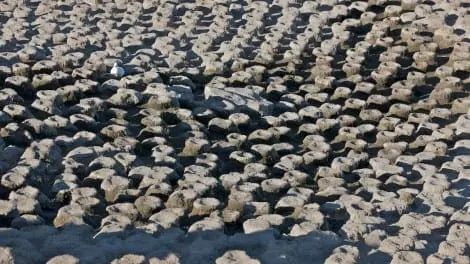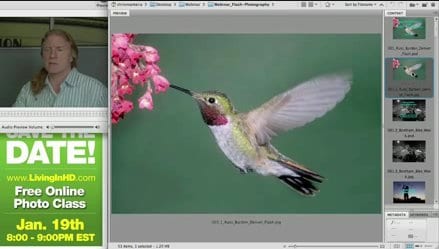DPA Magazine
Compose your Pattern
© Russ Burden When approaching a potential subject, look for an area that’s clean and has strong lines. Target this portion and begin to work it into a composition. Look for a prominent focal point and place it in the rule of thirds. Arrange the elements so lines lead the eye to the key part of the image. As a rule of thumb, try to have the eye enter from the lower left and be lead up and into the picture. This creates a smooth transition as the viewer explores the photograph.
Attention to Detail
© Allen Birnbach What drew me to photograph this aw this detail of an old radiator from a Model T Ford is that hidden within what appeared to be a perfectly repeating pattern where some wonderful nuggets. First, though the image appears to be monochromatic, there are some wonderful subtle colors in the copper tubing. And beyond that, the seemingly perfect rows of identical fins are broken up by bent units that have a seashell quality that invite a closer look.
A Sense of Scale
© Josh Anon I came across this huge field of empty king cormorant nests in the Falklands, but this pattern wasn′t very interesting without a sense of scale. Fortunately, a bird walked into the scene and sat down, breaking up the pattern/providing a focal point and a sense of scale.
John Bentham′s Taking Better Photos with Flash Webinar
On December 15, 2009, John Bentham hosted a one-hour webinar on how to take better photos with flash.
The Spirit of Family
Making a great family photo is all about the spirit of the family - if they are an exuberant bunch, it′s up to the photographer to capture that! One approach is to mirror the emotions you′ll want to elicit - while looking through the camera yell, laugh, say silly things, keep asking for more and more and more... while paying attention to the action, and looking for the peak moment to release the shutter. Try to position the group in the shade, facing towards the open sky - be sure to have no sunlight hitting them directly! Bring an old white bed sheet, and throw it on the ground in front of them - it will reflect light into the shadows, and keep some of the green light reflected off the grass, off them! Finally, it doesn′t hurt to pull out the Lensbaby! Everyone loves the soft, romantic look it creates - especially Mom! Take lots and lots of frames quickly, then edit them later in your computer for your best shot!
Traveling and Navigating the Light with a Point & Shoot Camera
© Jana Perez Using a point-and-shoot camera can have its advantages – especially when traveling – because they are small and lightweight. But, with this concession, there is often a loss of control in tricky lighting and other unexpected shooting situations. One way to offset this is by paying close attention to the light. Typically while traveling, days will be spent sightseeing, and the light changes as the day progresses into night. © Jana Perez If the sun is high in the sky, try shooting with the flash as fill in harsh daylight and in the shade. I caught this horse-drawn carriage driver resting between fares and reading the paper. The sun was very high, so the light was very bright in the open, and much darker in the shade. By using the flash, the difference between the shadow and bright light was minimized. If there is absolutely no shade and the flash is ineffective, try using a dramatic crop, up close/macro shot, or unique angle. Compose the existing light to balance out the composition. If using the flash at night, take a few steps back and zoom in – the method used to capture this image in an Irish pub with a sing along piano player. Another technique involves forcing the flash off, using the natural light and propping the camera on something. This can add drama and feeling to a seemingly simple setting. Lastly, if you are unsure of the light, try several mode settings that seem to address a similar kind of lighting.
Great cathedrals, require great lighting
© Bob Blanken Great cathedrals make for great images. The exposure in any auto mode, including Aperture or Shutter priority, should have an exposure compensation of -2, using ETTL or center-weighted. Bracket up/down 1 stop. In manualmode, just under exposure 2 stops, and bracket. You get dark, rich shadow areas and the highlights should be right on. © Bob Blanken Use that tripod you should be taking with you. Night time is a wonderful time to capture images. Bracket your exposure. Use the incandescent WB setting or better create a custom white balance.
John Bentham′s Halloween Webinar
On October 13th, John Bentham hosted an hour long webinar on taking Halloween photos including submissions from all 60 DPA instructors around the country.
John Bentham′s Back-to-School and Fall Colors Webinar
On September 15th, John Bentham tackled two birds with one webinar - Back-to-School Photography and Photographing Fall Colors.
Utilizing Window Light
This shot took advantage of window light from the left to illuminate 82 year-old Sonny Solot, with the camera on the bar top for its half 1/8 of a second exposure. Sometimes I can get lucky hand-holding an 1/8 of a second, but I had a big bar top available to me, a subject that luckily didn’t move much, and a glorious large north-facing window, providing a large naturally lite portrait on the go. By using the Lensbaby, I kept Sonny in focus and blurred the background. I saturated the image a little in Photoshop, but that was all. In Arizona, where we get over 300 bright and sunny days a year, window light is seen as if it were the light at the end of the tunnel, it’s the soft flat directional light that gives subjects dimension. If all else fails, place your subject by window light, you will be happy with the results. © David Sanders












